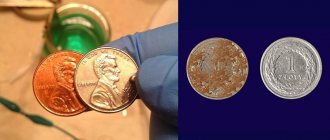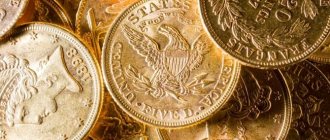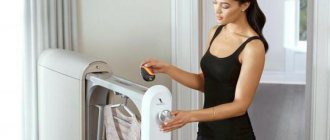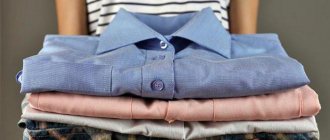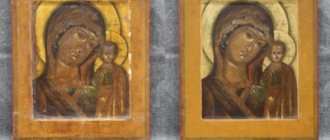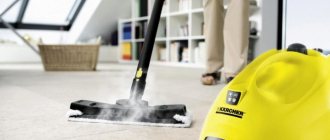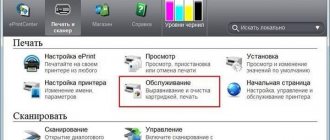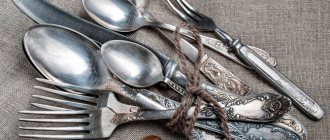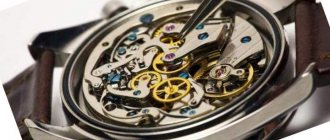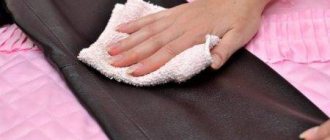It is known that the market value of an old and not very old coin consists of the following factors: its rarity (circulation), the metal of manufacture and, of course, the quality of preservation. Indeed, all other things being equal, a coin in excellent condition can cost many times more than the same coin, but dirty, rusty and worn.
That is why many are interested in the answer to the question of how to clean coins at home. In fact, this question is ambiguous and it is very risky for a beginner to take on the task of cleaning a rarity himself. If improperly cleaned, you can remove a valuable layer of patina from the coin disc or even damage it, which will negatively affect the final auction value.
Let's look at the most gentle ways to clean coins from rust, oxidation and black deposits to a shine at home, depending on what metal they are made of, as well as some universal methods.
Universal methods
By the way, there are universal cleaning methods that are safe for coins made of any metal. Let's take a closer look at some of them.
Soap solution
The most non-aggressive is a pasty or liquid, but very concentrated solution of ordinary soap. The soap is grated on a fine grater and mixed with water until it becomes pasty. If it is heavily soiled, you can soak the coin in this solution for 8-10 hours, then rub it with your fingers.
Leuchtturm special product
In the field of numismatics, a special coin cleaning product from the Leuchtturm company is known. 15 minutes after soaking the banknotes, you can wash off the dirt and clean off any existing corrosion. Also, some selective household chemicals, such as Metal Cleaner from Amway, are used to wash away dirt and plaque.
Toothpaste
Toothpaste with abrasive particles is also widely used, but in order to avoid damage to the coin and the appearance of small scratches on it, we recommend using softer types of toothpaste, for example, for sensitive teeth.
Remember! If you get your hands on a very rare and, quite possibly, expensive coin, it is better not to risk it and entrust its cleaning to a professional restorer.
After cleansing
After the procedure, the coins are boiled to completely remove dirt and cleaning agents. Then the money is dipped alternately in acetone and alcohol for 30 minutes to dry. A protective coating in the form of synthetic resins or paraffin is applied to dried surfaces. Preserved items are stored in plastic capsules or in separate compartments in collection albums.
Coins should not be touched with bare fingers. Money is taken with tweezers or numismatic gloves made of polyester or cotton are worn when working, otherwise fingerprints will appear on the surface. Later, these traces will darken and the value of the collection will decrease. Do not work with rubber gloves: rubber worsens the condition of alloys.
Collection samples are taken while wearing gloves.
Cleaning coins is a labor-intensive task, but every numismatist is pleased when the collection’s specimens look well-groomed. When cleaning rubles from oxidation and dirt, do not forget that the purity of the artifact and the preservation of the relief influence the collection value. Therefore, cleaning products and methods are chosen carefully so as not to damage the coating or smooth out parts.
Cleaning brass coins at home
Money made from a copper-zinc alloy is not particularly susceptible to corrosion, but still needs cleaning. The most commonly used methods are:
- A thick soap solution made from baby or laundry soap, finely grated and mixed with water, will perfectly clean brass coins, but you will have to be patient. This procedure may take several weeks. The money is then washed with warm water and cleaned with a soft toothbrush.
- Cleaning with citric acid takes less time - only 10-15 minutes, but it is important not to overdo the concentration, since this acid is quite aggressive towards metals.
- Oxalic acid, which is easily found in a regular store, also copes with dirt deposits on brass coins. To do this, you need to immerse the money in acid for literally 5-10 minutes, then rinse thoroughly and dry.
- Brass coins are cleaned by immersing them in the famous drink Coca Cola. Phosphoric acid, which is part of Coca-Cola, can effectively remove dirt and patina from the surface of a coin disc.
How to remove rust
Acids are used against corrosive growths - hydrochloric, formic, sulfuric. Aggressive compounds are diluted with water, and the condition of the coin is constantly monitored in order to stop the session in time. After peeling off the dirty layers, the active ingredient is neutralized with soda or soap. At home, a thin layer of rust is removed using available means - Coca-Cola, kefir: these drinks also contain acid (phosphoric acid, lactic acid, respectively). The specimen is kept in an acidic product, turning over periodically. When the rusty layers begin to peel off, the procedure is interrupted. Dirt is removed with a soft brush.
Cleaning Copper Coins
Depending on the color of the patina formed on the copper coin, there are different cleaning methods:
- A brown, red or purple patina “indicates” the presence of copper oxide on the coin disc, which can be easily removed with a 15% ammonia solution.
- A whitish patina is a sign of a lead ligature on a copper surface; it is removed after the coin has been in distilled water for several days. After this, the coating becomes loose and can be easily wiped off with a cloth.
- The yellow patina indicates that there is a lead alloy on the copper surface, which can be dissolved with 10% acetic acid.
- Blackening on a copper coin disc can be removed using the following methods: vinegar test, ammonia, boiling in oil (olive, vaseline or sunflower oil is most often used), 5-20% solution of sodium hexametaphosphate. More gentle, but also the longest in terms of time, is soaking a coin in kefir - unusual, but effective.
Features of the content of copies
High humidity and exposure to direct ultraviolet radiation are not allowed. Properly storing coins at home means using special organizers. They differ in materials and cost.
- Albums. They come with a fixed number of sheets and replaceable ones. Suitable for short-term storage. It is recommended to choose plastic options. PVC albums should be avoided.
- Holders. Envelopes made of cardboard with transparent walls. They are stapled or glued to paper. They need to be replaced with new ones twice a year, which is not very convenient.
- Envelopes. Popular with newbie collectors. There are paper or plastic. They are easy to use, inexpensive, but need to be changed frequently.
- Capsules, weak. The most reliable storage methods, but they are expensive. The products are sealed hermetically. Information about the coin is indicated at the top.
- Cases. They are presented in a wide variety, but have a high cost. Provide the highest quality storage conditions. The design includes shelf tablets, and coins are placed in separate cells.
Muntzkabinets are similar to cases. Made from expensive wood. In most cases, they are used not as functional, but as status storage.
Cleaning silver coins
Silver coins, along with copper ones, are most often found in treasures. Here are the options for cleaning them:
- The most gentle and accessible way is to clean silver coins with soda mixed with water to a paste-like state. This mixture also allows the coin to return to its original shine.
- Green deposits on the surface of a precious metal coin can be removed using a weak solution of sulfuric acid, which is poured into a ceramic cup and the silver coin is placed there. Periodically, the coin is cleaned of softened plaque and placed back into the solution. After the green coating is completely removed, the coin is washed for at least 15 minutes under tap water.
- In order not to take risks with sulfuric acid, which in high concentrations can damage small relief details, you can replace it with citric acid, but the cleaning time will be longer.
Cleaning with special means
Noble metals and alloys are treated with special cleaning compounds.
Additional Information! Special agents are diluted according to instructions. The artifacts are periodically turned over to ensure uniform coverage of the liquid. To enhance the effect of the drugs and speed up cleaning, coins are first degreased or washed in soap suds.
Effective means for processing metal money. The
following preparations will quickly destroy traces of oxidation, corrosion, and wash away dirt, without damaging the material:
- Trilon-B cleans brass, nickel silver, cupronickel from rust without affecting the metal; returns the original color to products with minimal damage; Coppers after cleaning get a pinkish tint.
- Silbo – liquid for copper and nickel money; removes plaque and rust.
- Asidol-M – contains ammonia, surfactants, wax; Cleans and polishes banknotes made of steel and non-ferrous alloys in a couple of minutes.
- Shine Coins - under this brand, separate compositions are produced for products made of silver, copper, nickel, bronze and brass.
- Nanopatina is a means for processing copper. Contains copper sulfate, active ingredients. Apply to a degreased and washed surface. After the procedure, air dry for 5 minutes, then wash.
- The paste-like preparation “USSR” based on nanodispersed abrasive contains tartaric acid salts and sodium bicarbonate. Cleans copper, bronze, brass.
- Leuchtturm - a series of liquids for products made of gold, silver, copper; preparations contain different doses of inorganic acidic substances, sulfur compounds, softeners, nychtinol (<5%); restores color and does not add unnatural gloss.
- Ointments, powdery substances, liquids from the Etalon series (“Gold”, “Silver”, “Copper”) remove traces of rust; restore the natural shine of metal coatings; form a protective layer - patina.
A universal preparation for cleaning metals and alloys,
Nanotrilan paste contains oxalic acid and microdispersed abrasive substances. Suitable for cleaning USSR money, new 10-ruble and foreign banknotes. Apply to the contaminated surface and gently rub with flannel.
Cleaning bronze coins
Cleaning procedures for bronze coins are similar to those used to give copper coins a marketable appearance. Collectors usually use:
- toothpaste,
- Trilon solution,
- Various acids
- Ammonia.
Attention! When cleaning with ammonia (5-15% ammonia solution), you need to be especially careful. The coin is dipped into the ammonia solution and periodically rotated in it, but it is strictly forbidden to remove it from the concentrate. After completing the cleaning process, you must first, by gradually adding water, reduce the concentration of ammonia and only then take out the money.
Useful tips
- Sometimes, during the cleaning process, ancient bronze coins lose their noble patina, for which many collectors are even willing to pay extra. Therefore, “traditional craftsmen” have contrived to apply patina on their own - to do this, just place the money in a 10% hyposulfite solution for 10 minutes. This coating looks quite attractive and also protects the coin disk from corrosion.
- Avoid using brushes with metal bristles, which can damage the surface of the coin and ruin its appearance.
- GOI paste is the worst solution for cleaning coins using improvised materials. It ruins the fine details on the coin and damages the patina.
- Do not use aggressive acids when cleaning - they may destroy the coin.
